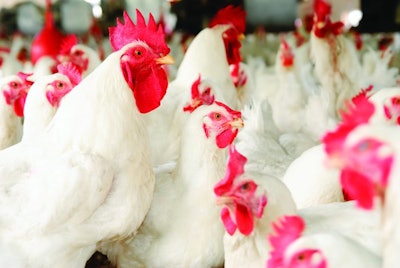
While consumers average rating for their current financial situation is in the middle between “poor” and “excellent,” 87 percent are buying more or the same amount of fresh chicken now compared to six months ago, according to research presented today at the 2022 Chicken Marketing Summit.
The National Chicken Council (NCC) and WATT Global Media presented the results of a study that focused on current and anticipated US consumer behavior, specifically, consumption of fresh chicken. The results suggest opportunities for chicken to maintain market share. IRI provided supporting data from its retail databases. The study was commissioned by NCC and conducted online by IRI June 30 – July 5, 2022, among 537 U.S. adults. Funding was provided by Elanco Animal Health, Evonik Animal Nutrition, NCC and WATT Global Media. A full copy of the presentation is available by clicking here.
Chicken continues to be the healthy choice, best value for the money
During the past six months, 99 percent of those surveyed said they eat meals made with fresh chicken more than once a month; 88 percent do so more than once a week.
U.S. consumers plan to buy more chicken than other types of protein in the twelve months ahead. Chicken purchasers cite nutrition, value and versatility as the top reasons for consuming more chicken. When asked about the fresh proteins they plan to consume in the next 6-12 months, 37 percent said they plan to consume more chicken, while 15 percent plan to consume more beef and 14 percent plan to eat more pork.
Rising prices are attributed to higher costs of fuel, labor and chicken feed
85 percent of respondents recognize that chicken prices are higher than at the start of the year. When asked why they believe those prices are rising, 52 percent said higher energy and gas prices, 44 percent said higher wages and worker shortages across supply chains and 42 percent cited higher prices for chicken feed. “U.S. consumers are being faced with higher costs for everything,” said Tom Super, NCC senior VP of communications. “However, the data show they are continuing to rely on chicken as a healthy and affordable protein source to feed their families.”
Despite evidence of intention to trade down to less expensive cuts, store brand from name brand, and value-size packs, 53 percent are keeping chicken “center of the plate,” according to the research. Chris DuBois, IRI, noted, “Chicken is advantaged by the fact that Millennials buy more of it than other age groups, as well as the evidence that shows less price sensitivity for chicken than for other proteins.”
While 37 percent say they will continue to eat at home the same amount, 57 percent of those surveyed said they plan to eat more meals at home than during the past six months. While 40 percent will continue to order delivery or takeout from restaurants, only 11 percent plan to increase that activity. “Eating at home saves money on food and transportation,” said Joyce Neth, WATT Global Media. “Chicken is versatile and is a family-pleaser for the home cook.”
Other than price, sustainability is a consideration
Consumers were asked to rate the importance of sustainability benefits when buying fresh chicken. More than half of respondents rated sustainability as very or somewhat important.
Animal welfare, packaging and carbon footprint were among the benefits rated. Neth showed examples of packaging with clear statements of benefits, “Give consumers information in simple language. Awareness is growing. Help them feel good about the chicken they are choosing.”
DuBois added, “Carbon neutrality will be a huge trend. We’re seeing it across other industries and that will increase awareness for food.”
Keys for profitable growth going forward
Producers, retailers and foodservice should focus on price strategies, price forecasting, promo investment, targeting communications and innovation going forward. “When the dust settles in 2023, if you’ve raised prices 20 percent over that period, you’ll be left with a higher-priced brand that needs to be supported with some sort of value proposition. Whether it’s a special benefit, package or ingredient, consumers will seek a justification for the higher prices and good reasons not to switch to a less-expensive brand,” said DuBois.
In addition, sellers need to be mindful of the millennial shift that is occurring. “Millennials are replacing Boomers for share of spend. They buy different products and chicken is well-positioned as a preferred protein. Target communications and offers to them to maintain that advantage,” said Neth.
Chicken has proven to be ‘inflation’ proof. According to USDA, Americans on average will eat a record 98.3 pounds of chicken per person this year. Chicken consumption is nearly twice that of beef and pork. Chicken outpaced pork in 1984 and surpassed beef as America’s favorite meat in 1991.
Attend the 2023 Chicken Marketing Summit
Serving a unique cross section of the chicken supply chain, The Chicken Marketing Summit explores issues and trends in food marketing and consumer chicken consumption patterns and purchasing behavior.
The dates and location of the 2023 Chicken Marketing Summit will be announced soon!
For more information and to attend, visit: www.wattglobalmedia.com/chickenmarketingsummit/.

















